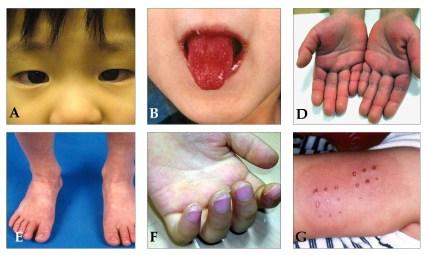By Charles Lam
Northwest Asian Weekly

Common symptoms of Kawasaki Disease include fever, swelling, redness, strawberry tongue, and cracked skin. (Photo from the National Institute of Health)
Asian and Pacific American children are susceptible to an autoimmune disease that attacks the blood vessels, skin, lymph nodes, and other organ systems, even causing heart attacks. But pediatricians may not be checking for it.
That’s because the disease — Kawasaki Disease (KD) — is rare, and the symptoms are often associated with common childhood diseases. Symptoms include fever, rash, red eyes, redness of the skin, and more.
“A parent should suspect KD if their child has more than five days of high fever, and at least three of the clinical criteria, which includes rash, swollen lymph nodes, swollen hands or feet, red eyes, and red lips with peeling or cracking and/or a strawberry tongue,” said Dr. Michael Portman, a professor of pediatrics at the University of Washington and the director of the Seattle Children’s Hospital’s pediatric cardiovascular research group. “They should go to their pediatrician, and make certain that KD is at least considered.”
KD causes a child’s immune system to attack perfectly healthy cells. It specifically affects blood vessels and can lead to damage to the arteries of the heart. Children who receive late or no treatment are at risk of heavy cardiac damage, with some cases showing young children with the heart health of a middle-aged smoker. Left untreated, the disease kills one percent of those affected. Treatment is recommended within five days of fever to most effectively cut down the chance of heart disease.
The disease reportedly affects roughly one in 6,000 children under the age of 5, but among Asian and Pacific Islanders, that number is much higher. In Japan, where the disease is most well known, KD affects one in roughly 500 children under the age of 5. In the Pacific Islands, it affects one in approximately 1,000. At the Seattle Children’s Hospital, nine percent of admitted patients are Asian or Pacific American, but roughly 22 percent of patients admitted with KD are APA.

Dr. Michael Portman
First described in 1967 by Dr. Tomisaku Kawasaki in Japan, KD is not currently well understood. Its causes are currently unknown, and there is no direct test for the disease. Though a treatment exists, it is expensive, time consuming, and can be uncomfortable. But research at Seattle’s Children Hospital Research Institute is attempting to address these issues.
The Portman Research Group, a team of doctors from the United States and Japan led by Dr. Portman, is working on everything from developing a test for the disease, identifying genetic mutations that make an individual more susceptible to KD, finding a cheaper and more effective treatment, and identifying its root causes.
Progress is encouraging. A current trial of a new treatment with approximately 500 participants is showing promise. Of the 15 preliminary patients, none needed a second course of treatment. The proposed treatment would shorten the time needed weekly from 12 hours to a few moments. It could reduce the cost of treatment by 95 percent.
Currently, those undergoing treatment must go through intravenous immunoglobulin (IVIG) therapy, requiring 12 hours of hospital time with an IV. One dose of the IVIG therapy with hospitalization time may cost up to $10,000. The new therapy, which uses a drug currently used to treat rheumatoid arthritis, is administered through subcutaneous injection, much like insulin pumps used to treat diabetes. One dose of the new treatment costs between one-fourth to one-sixth of the IVIG treatment.
There are currently two more years in the study timeline.
Progress toward the identification of the cause of KD is also encouraging. Though more research is needed, an analysis of available data shows a possible connection between the consumption of soy and incidence of KD.
The American Academy of Pediatric already recommends avoiding soy-based food due to the existence of estrogen-like proteins in soy. The possible connection between KD and soy is another reason to avoid soy in the diets of young children.
But though research is moving along, there have been some hurdles. Funding for research into KD and other rare diseases have become more sparse due in part to the sequestration of the United States budget. Despite the setbacks, hope for progress endures through the help of independent donors. (end)
For more information about the Seattle Children’s Hospital and Kawasaki Disease research, visit www.seattlechildrens.org.
Charles Lam can be reached at Charles@nwasianweekly.com.



